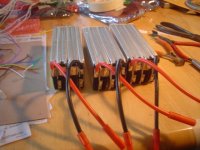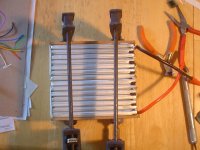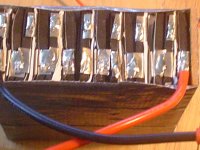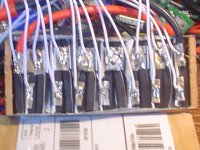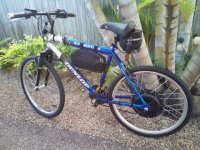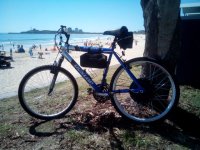Hi everyone
This is my first post here, although I've been lurking for a while.
I,m a mature age bloke living on the Sunshine Coast Australia. I have enjoyed riding my bikes, just for recreation for many years, and I've recently got interested in ebikes after having a couple of test rides on some very nice ones at an excellent local specialist ebike shop.
I came away thinking that they were great fun, but way to expensive for the amount of use I would give one, particularly as I love my pedal power bikes, and still like to have a ride on one of those most days.
However, I came across this site, and started getting keen on the idea of building one. I don't want to spend heaps of money at this stage, just want to get something basic going, to see if I will use it much.
With that in mind, I was looking at kits on eBay & saw one that only had a few minutes to go, & still seemed quite cheap. I put a bid on it & ended up winning it.
It's a direct drive rear wheel kit, supposedly 36v 500w, the same as this one
http://m.ebay.com.au/itm/111454303644 .I ended up paying just under $150 shipped. There seems to be quite a few similar ones at 36v & 48v of various wattages, from this seller, and a couple of others, on eBay aus, & they say they ship from Sydney. I would probably have gone for a geared hub motor, but nothing cheap like this on eBay & suppliers like BMS battery, or GreenBikeKit, would want more than this one cost, just for shipping.
Anyway, I've done it now, so I'm looking forward to getting it delivered, & giving it a try. I'm thinking I'll power it with HK lipo, to keep things cheap (I've read up on the risks).
Now the questions start.
I know that 10s lipo is usually the go for a 36v system, but I'm wondering if I should go for 12s in case I want to upgrade to something 48v later?
I'm guessing that the motors on those similar kits are the same, and they just rate the voltage & wattage according to the controllers they put with them. Does that sound about right?
Would it be likely that the controller that comes with this could take the increased voltage of 12s lipo, or would I fry it?
Can those generic Chinese controllers be modded to take higher voltage?
What about the throttle with battery indicator, is that voltage dependant?
I' m guessing the motor is just an unbranded sensorless DD unit. Does that sound about right?
Does anyone know anything about those, or had any good/bad experiences with them, or with kits like this?
One other thing. It comes with PAS. I can't see anything to change the levels. Could I do that if I got some sort of LED or LCD display?
If it is just one level, does that mean it will just be full on assist when ever I pedal?
Hope I'm not asking too many noobie questions when I haven't even had the thing delivered yet. I expect I'll have a heap more when it arrives.
Cheers
This is my first post here, although I've been lurking for a while.
I,m a mature age bloke living on the Sunshine Coast Australia. I have enjoyed riding my bikes, just for recreation for many years, and I've recently got interested in ebikes after having a couple of test rides on some very nice ones at an excellent local specialist ebike shop.
I came away thinking that they were great fun, but way to expensive for the amount of use I would give one, particularly as I love my pedal power bikes, and still like to have a ride on one of those most days.
However, I came across this site, and started getting keen on the idea of building one. I don't want to spend heaps of money at this stage, just want to get something basic going, to see if I will use it much.
With that in mind, I was looking at kits on eBay & saw one that only had a few minutes to go, & still seemed quite cheap. I put a bid on it & ended up winning it.
It's a direct drive rear wheel kit, supposedly 36v 500w, the same as this one
http://m.ebay.com.au/itm/111454303644 .I ended up paying just under $150 shipped. There seems to be quite a few similar ones at 36v & 48v of various wattages, from this seller, and a couple of others, on eBay aus, & they say they ship from Sydney. I would probably have gone for a geared hub motor, but nothing cheap like this on eBay & suppliers like BMS battery, or GreenBikeKit, would want more than this one cost, just for shipping.
Anyway, I've done it now, so I'm looking forward to getting it delivered, & giving it a try. I'm thinking I'll power it with HK lipo, to keep things cheap (I've read up on the risks).
Now the questions start.
I know that 10s lipo is usually the go for a 36v system, but I'm wondering if I should go for 12s in case I want to upgrade to something 48v later?
I'm guessing that the motors on those similar kits are the same, and they just rate the voltage & wattage according to the controllers they put with them. Does that sound about right?
Would it be likely that the controller that comes with this could take the increased voltage of 12s lipo, or would I fry it?
Can those generic Chinese controllers be modded to take higher voltage?
What about the throttle with battery indicator, is that voltage dependant?
I' m guessing the motor is just an unbranded sensorless DD unit. Does that sound about right?
Does anyone know anything about those, or had any good/bad experiences with them, or with kits like this?
One other thing. It comes with PAS. I can't see anything to change the levels. Could I do that if I got some sort of LED or LCD display?
If it is just one level, does that mean it will just be full on assist when ever I pedal?
Hope I'm not asking too many noobie questions when I haven't even had the thing delivered yet. I expect I'll have a heap more when it arrives.
Cheers











